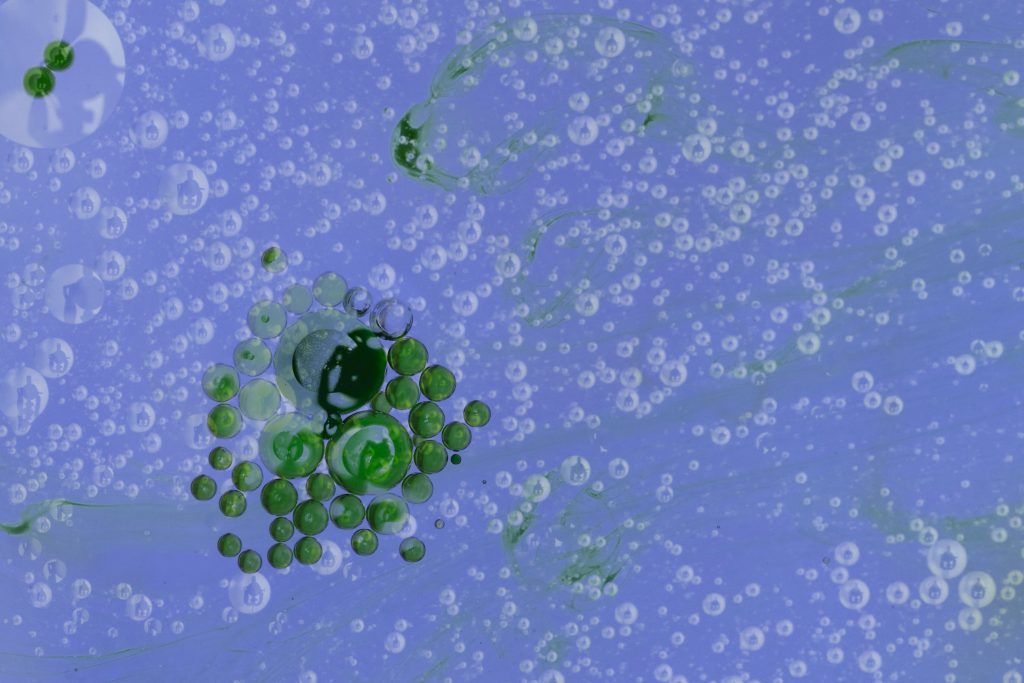
We are all familiar with macroalgae, commonly simply referred as “algae,” i.e. multi-cellular photosynthetic aquatic organisms similar to plants. Less known, perhaps, are the microalgae, microscopic photosynthetic unicellular organisms that are ubiquitous in aquatic ecosystems.
The term “microalgae” actually refers to both eukaryotic (i.e., with a membrane-bounded nucleus) and prokaryotic (i.e., without a well-defined nucleus) microorganisms. Prokaryotic microalgae are cyanobacteria, commonly known as “blue-green algae” because of their characteristic coloration.
Cyanobacteria are evolutionarily ancient organisms; their origin is believed to date back more than 3.5 billion years ago and they are thought to be the first organisms capable of performing photosynthesis, thus contributing in a major way to the formation of oxygen in the oceans and the proliferation of life on Earth. Perhaps few people know that, even today, more than half of the atmospheric oxygen is globally produced by microalgae themselves, so they are of key ecological importance to our Planet.
But their utility for a greener, more sustainable future goes far beyond that.
We are aware that we are eroding the natural resources and causing anthropogenic pollution which is leading an increase in greenhouse gas emissions, consisting mostly (>75%) of CO2, which is progressively causing the drastic climate changes we are witnessing. In addition, the world population is estimated to increase up to 9 billion people by 2050. Thus, on the one hand the need to reduce environmental impact and on the other hand the need to find alternative sources of food so as not to burden the limited water and arable land resources. How to combine these needs? Microalgae can come to our rescue. Here is how.
Microalgae for climate neutrality
Microalgae are capable of capturing CO2 more efficiently than terrestrial plants, and they also grow faster and do not require arable land or potable water- and they growth can also be coupled with wastewater treatment- thereby enabling more efficient resource management. It has been estimated that the production of 280t of dry biomass per hectare per year can remove about 513t of CO2. The obtained algal biomass can be further exploited for a wide range of applications: third-generation biofuels for the renewable energy sector; high-value products for nutraceuticals, pharmaceuticals and cosmetics; proteins as feed substitutes; as well as biostimulants and soil conditioners for agriculture.
Data in hand, it is therefore not surprising that in recent decades unicellular algae have received great interest from both science and industry as a promising alternative in the renewable energy sector and as environmentally friendly “new foods.”
Microalgae: learning from the past for the food of the future
Seaweeds have been harvested and consumed by coastal communities around the world since the beginning of human civilization, based on the earliest archaeological evidence dating back some 14,000 years. Today, thanks to an increasing internationalization of eating habits, we are becoming more and more accustomed to seeing macroalgae in our dishes. Just think of the delicious seaweeds NORI (Porphyra/Pyropia spp.), KOMBU (Laminaria/Saccharina spp.) and WAKAME (Undaria spp.), typical of Asian cuisine.
But microalgae have also been known since ancient times as foods of high nutritional value. For example, the cyanobacterium Spirulina (common name of the genus Arthrospira) is known to have been a staple for the populations of Latin Americans already in the 16th century. As described by one of Cortés’s soldiers, the Aztecs collected Spirulina from Lake Texcoco, called Tecuitlatl by the locals, (literal meaning ” stone’s excrement ” because Spirulina was collected from the rocky shores by the lake). It was dried and used to make and sell flat green loaves with a cheese-like taste or eaten in combination with other foods. Today Spirulina has been rediscovered as a 21st century “super food” because of its extraordinary nutritional properties. In fact, it is particularly rich in protein and vitamins, as well as minerals and essential fatty acids. At present, it is globally the most widely marketed microalgae-based dietary supplement. It is now so popular that even large international chains such as IKEA have included it on vegetarian menus.
Besides Spirulina, the main species produced on a large scale and commercially available are the green algae species: Chlorella, Haematococcus, and Dunaliella. Similar to Spirulina, Chlorella is rich in protein, polysaccharides, lipids, vitamins and carotenoids and is mainly marketed as a nutritional supplement. While Haematococcus and Dunaliella are cultivated primarily for the production, under stress conditions, of high-value carotenoids, astaxanthin and beta-carotene, respectively.
Microalgae precious green factories
The Institute of Agricultural Biology and Biotechnology of the CNR, headquartered in Milan, holds a rich collection of microalgae strains (cyanobacteria, green algae and diatoms) and it is committed to the studies of the physiology and photosynthesis of these microorganisms with a view to improving their photosynthetic efficiency and implementing innovative biotechnological processes aimed at the use of these valuable green factories for the capture and valorisation of CO2 and agri-food industry wastes into high value-added products, with a focus on carotenoid pigments.
In our research project “CYAO: Cyanobacterial Platform Optimised for Bioproduction”, funded by Fondazione Cariplo and recently concluded, we developed a strain of cyanobacterium capable of efficiently synthesizing the valuable astaxanthin, to date naturally produced under stress conditions only by the green algae Haematococcus, as mentioned above. This production therefore suffers from severe limitations in the quantity and quality of yields, hence the interest in developing an alternative biological system for its synthesis. Astaxanthin is currently the carotenoid with the highest market price since it is of key importance in the aquaculture sector, being the pigment that gives the classic pink coloration to shrimps and fish (e.g., salmon trout), but it also finds wide applications in the nutraceutical, cosmetic, and pharmaceutical sectors due to its extraordinary antioxidant properties and numerous beneficial effects on human health.
Thus, our cyanobacterium “CYAO” could find numerous uses in different areas of application interest. “CYAO” will soon be validated in laboratory-scale photobioreactor systems. Looking forward, optimized large-scale production could be a viable alternative to the current astaxanthin production system.
Author: Barbara Menin